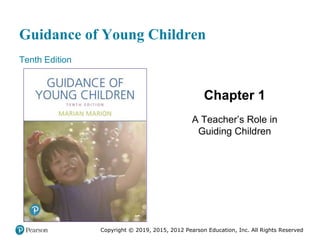
Marion 10 Chapter 1
- 1. Guidance of Young Children Tenth Edition Chapter 1 A Teacher’s Role in Guiding Children Copyright © 2019, 2015, 2012 Pearson Education, Inc. All Rights Reserved
- 2. Copyright © 2019, 2015, 2012 Pearson Education, Inc. All Rights Reserved Learning Objectives • Defend the idea that teachers must develop good relationships with children to guide them effectively. • Explain the two major dimensions of a teacher’s style of caregiving. • Describe major caregiving styles in terms of an adult’s level of demandingness and responsiveness. • Explain the basic processes through which teachers influence children.
- 3. Copyright © 2019, 2015, 2012 Pearson Education, Inc. All Rights Reserved Developing Good Relationships with Children First step in guiding children effectively: develop good relationships with them • Demonstrate respect and show interest • Acknowledge and learn about children • Find out what is important to children • Pay attention (no texting, emailing, or other conversations) • Show appreciation • Show genuine enjoyment in your interactions with children
- 4. Copyright © 2019, 2015, 2012 Pearson Education, Inc. All Rights Reserved Major Dimensions of Caregiving Styles There are two dimensions of caregiving • Responsiveness • Demandingness
- 5. Copyright © 2019, 2015, 2012 Pearson Education, Inc. All Rights Reserved Responsiveness Refers to an Adult • Warmth • Child development knowledge • Belief that she/he is a partner with a child in any interaction • Communication style • Willingness to give explanations
- 6. Copyright © 2019, 2015, 2012 Pearson Education, Inc. All Rights Reserved Demandingness Refers to an Adult’s Knowledge and Skills • In setting boundaries, limits, and expectations • In monitoring and supervising children • With guidance strategies • In confronting children when necessary
- 7. Copyright © 2019, 2015, 2012 Pearson Education, Inc. All Rights Reserved Three Styles of Caregiving There are three styles of caregiving • Authoritative • Authoritarian • Permissive
- 8. Copyright © 2019, 2015, 2012 Pearson Education, Inc. All Rights Reserved Authoritative • Positive style • High in “demandingness” • High in “responsiveness”
- 9. Copyright © 2019, 2015, 2012 Pearson Education, Inc. All Rights Reserved Permissive The two forms of permissive include: • Indulgent • Uninvolved
- 10. Copyright © 2019, 2015, 2012 Pearson Education, Inc. All Rights Reserved How are These Forms of Permissiveness the Same? How are They Different? Indulgent • Low in demandingness • Highly responsive to children: warm, nurturing • Made active choice to be permissive Uninvolved • Low in demandingness • Not very responsive to children • Does not want to be permissive
- 11. Copyright © 2019, 2015, 2012 Pearson Education, Inc. All Rights Reserved An Adult’s Style of Caregiving Affects Children’s Development (1 of 4) Authoritative caregiving helps children to feel: • Safe • Secure • Competent
- 12. Copyright © 2019, 2015, 2012 Pearson Education, Inc. All Rights Reserved An Adult’s Style of Caregiving Affects Children’s Development (2 of 4) Authoritative caregiving helps children to develop: • Empathy • Self-esteem • Core of personal values • Self-control • Self-responsibility
- 13. Copyright © 2019, 2015, 2012 Pearson Education, Inc. All Rights Reserved An Adult’s Style of Caregiving Affects Children’s Development (3 of 4) Authoritarian caregiving has a negative effect on children’s development: • Poor self-esteem • Poor self-control • Fosters aggression • Does not stop unacceptable behavior
- 14. Copyright © 2019, 2015, 2012 Pearson Education, Inc. All Rights Reserved An Adult’s Style of Caregiving Affects Children’s Development (4 of 4) Permissive caregiving has a negative effect on children’s development: • Poor impulse control • Not self-reliant • Not self-responsible
- 15. Copyright © 2019, 2015, 2012 Pearson Education, Inc. All Rights Reserved How Adults Influence Children Adults influence children through • Modeling • Instruction/teaching • Giving feedback • Managing the child’s environment • Stating expectations for appropriate behavior • Helping children understand ‘why’ • Helping children change their understanding and attitude
- 16. Copyright © 2019, 2015, 2012 Pearson Education, Inc. All Rights Reserved Copyright
Editor's Notes
- If this PowerPoint presentation contains mathematical equations, you may need to check that your computer has the following installed: 1) MathType Plugin 2) Math Player (free versions available) 3) NVDA Reader (free versions available)
